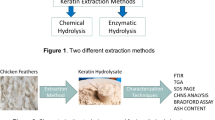Summary
Cod Gadus morhua and bovine trypsin degraded human epidermal keratin with similar efficacies in vitro around optimal pH, which was at pH 8.4 for cod trypsin and at pH 9.5 for bovine trypsin. Extract of intestines of cod, Atlantic herring Clupea harengus, Atlantic salmon Salmo salar, and redfish Sebastes marinus degraded keratin with similar efficacies with pH optima between 8.5 and 9.5. Sheets of plantar callus were degraded with somewhat lower efficacy than keratin. The keratin-degrading activity of extract of cod intestines had a temperature optimum around 45°C. Inhibition with benzamidine and 4-phenylbutylamine showed that trypsin amounted to more than 2/3 of the keratin-degrading activity in all extracts of fish intestines. Apart from cod intestines, which had the lowest chymotrypsin content, chymotrypsin made a smaller but significant contribution to the keratin-degrading activity. The present investigation demonstrates that fish trypsin and extract of fish intestines are effective in degrading human epidermal keratin in vitro, and in a recent investigation the same was shown with fish pepsin. This may suggest a possible mechanism for the development of irritative contact eczema caused by exposure to fish.
Similar content being viewed by others
References
Bjelland S, Gildberg A, Volden G (1988) Degradation of human epidermal keratin by fish pepsin. Arch Dermatol Res 280:119–123
Bjelland S, Volden G,Raa J (1988), A simple assay for determining keratin and collagen degradation in vitro. Arch Dermatol Res 280:50–53
Erlanger BF, Kokowsky N, Cohen W (1961) The preparation and properties of two new chromogenic substrates of trypsin. Arch Biochem Biophys 95:271–278
Hjelmeland K (1983) Proteinase inhibitors in the muscle and serum of cod (Gadus morhua). Isolation and characterization. Comp Biochem Physiol 76B:365–372
Hjelmeland K, Raa J (1982) Characteristics of two trypsin type isozymes isolated from the arctic fish capelin (Mallotus vilosus). Comp Biochem Physiol 71B:557–562
Hjelmeland K, Christie M, Raa J (1983) Skin mucus protease from rainbow trout, Salmo gairdneri Richardson, and its biological significance. J Fish Biol 23:13–22
Johnson WC, Lindsey AJ (1939) An improved universal buffer. Analyst (Lond) 64:490–492
Laskowski M Jr, Kato I (1980) Protein inhibitors of proteinases. Annu Rev Biochem 49:593–626
Lowry OH, Rosebrough NJ, Farr AL, Randall RJ (1951) Protein measurement with the Folin phenol reagent. J Biol Chem 193:265–275
Möslein P, Müller H, Feuerstein M (1962) Toxische Hautschäden bei Drüsensammlerinnen. Dermatol Wochenschr 145:449–453
Raith L (1976) Butcher's dermatitis in a meat inspector. Contact Dermatitis 2:61
Rothberg S, Axilrod GD (1967) Enzymatic solubilization of insoluble proteins at neutral pH. Science 156:90–93
Siebert G, Bottke I (1963) Enzyme in der Leibeshöhle von Fischen. Arch Fischereiwiss 14:57–68
Siebert G, vMalortie R, Beyer R (1962) Verdauungsenzyme frischgefangener Dorsche. Arch Fischereiwiss 13:21–34
Simpson BK, Haard NF (1984) Trypsin from greenland cod, Gadus ogac. Isolation and comparative properties. Comp Biochem Physiol 79B:613–622
Stüttgen G, Klofat H, Strauch M (1965) Die Reaktion der normalen und krankhaft veränderten menschlichen Haut auf intracutan und epicutan applizierte Endopeptidasen (Trypsin, Bromelin). Arch Klin Exp Dermatol 222:580–602
Tellnes G (1987) Skin diseases among fishermen in northern Norway. Tidsskr Nor Lægeforen 107:566–568
Tomlinson G, Shaw MC, Viswanatha T (1974) Chymotrypsin(s) Methods Enzymol 34:415–420
Volden G, Bjelland S (1988) Degradation of human epidermal keratin and induction of inflammation by proteolytic enzymes from fish. Arch Dermatol Res (in press)
Walsmann P (1977) Inhibition of serine proteinases by benzamidine derivatives. Acta Biol Med Germ 36:1931–1937
Author information
Authors and Affiliations
Additional information
This work is part of project no. III 406.001 supported by the Norwegian Fisheries Research Council (NFFR)
Rights and permissions
About this article
Cite this article
Bjelland, S., Hjelmeland, K. & Volden, G. Degradation of human epidermal keratin by cod trypsin and extracts of fish intestines. Arch Dermatol Res 280, 469–473 (1989). https://doi.org/10.1007/BF00427658
Received:
Issue Date:
DOI: https://doi.org/10.1007/BF00427658




